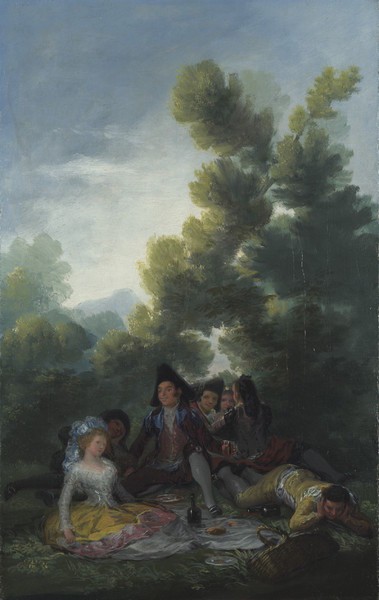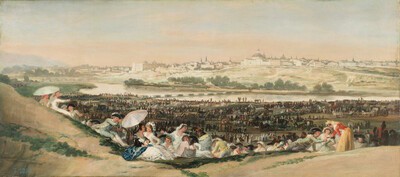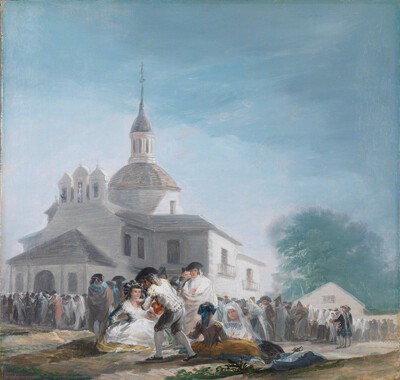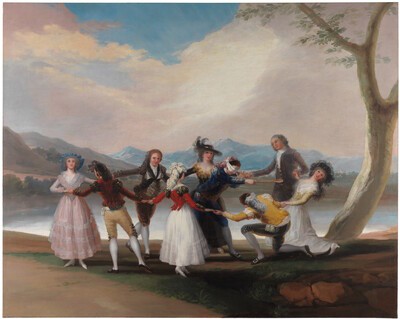- Cronología
- 1788
- Ubicación
- The National Gallery, London, United Kingdom
- Dimensiones
- 41.3 x 25.8 cm
- Técnica y soporte
- Oil on canvas
- Reconocimiento de la autoría de Goya
- Documented work
- Titular
- The National Gallery
- Ficha: realización/revisión
- 20 Dec 2009 / 14 Jun 2023
- Inventario
- (1961.9.74)
- Otros títulos:
-
The Picnic (La merienda)
The tapestry cartoon for which this sketch was made was never in fact painted. It formed part of the series that would have decorated the bedroom of the Infantas, a commission that Goya received towards the end of 1787 (see Blind Man's Buff).
The sketch was acquired from the artist by the Duke and Duchess of Osuna in 1798 and it remained in the cabinet that the Duchess had in La Alameda until it was sold at the time of the bankruptcy of the ducal household in 1896, when it was bought by the National Gallery, London.
Five men and two women are enjoying a picnic in the countryside. Behind them, a number of leafy trees close off the composition, making the horizon all but invisible to us and squeezing the figures into a crowded foreground. The majos are depicted in a number of different poses. The one in the centre directs his clearly lascivious, desirous gaze at the woman on the left, whilst the man on the right-hand side stretches out on the ground, probably in an advanced state of inebriation. The other men talk with the second woman, who is hidden behind them.
The dimensions of this sketch correspond with those of the third of the stretchers that appear in the invoice delivered by the carpenter Serrano. In the catalogue of objects put up for sale by the Duke and Duchess of Osuna, there is mention of a scene depicting a country picnic.
Yriarte had the opportunity to view the work in the Osuna residence in La Alameda, together with the sketches for Spring, Summer and Winter, which we know thanks to the description he gave of the piece, in which he praises it as "an authentic Spanish Watteau". Given that Yriarte had overlooked the sketch for Autumn, supposing that it was a small painting that the Goupil brothers had bought from Ángel Tadei, Arnaiz suggests that this sketch could be that of Autumn, justifying this hypothesis by pointing out the ochre hues and the presence of wine - the symbol of the September harvest - at the centre of the composition. What's more, this same writer states that it was very unlikely that the Osunas would have sold Autumn by itself and before the bankruptcy of the ducal household.
But if this hypothesis were correct and this painting were actually Autumn, a corresponding tapestry would have been made, and the cartoon sketch The Grape Harvest - which was made into a tapestry - would be the missing one.
Elsewhere, Tomlinson is of the opinion that the subject matter of this painting is not worthy of forming part of the décor of a royal bedchamber, and that the composition does not follow the pattern of open landscapes that Goya was employing throughout this series. The American writer links Country Picnic with another small painting, that of Stagecoach Hijacking, which also belonged to the Osunas, and puts forward the idea that Goya painted it specifically for them, in order to complement the works they had acquired from the painter in 1798.
An additional strip has been added around the four edges of the canvas.
Cleaned and restored in 1987.
-
El Greco to Goya. The taste for Spanish paintings in Britain and IrelandThe National Gallery of ArtLondon1981consultant editor Alan Braham. From September 16th to November 29th 1981cat. 66
-
Goya. El Capricho y la Invención. Cuadros de gabinete, bocetos y miniaturasMuseo Nacional del PradoMadrid1993from November 18th 1993 to February 15th 1994. Exhibited also at the Royal Academy of Arts, London, March 18th to June 12th 1994 and The Art Institute of Chicago, Chicago, July 16th to October 16th 1994, consultant editors Manuela B. Mena Marqués and Juliet Wilson-Bareaucat. 27
-
Francisco de Goya: Maleri, Tegning, GrafikkNasjonalgallerietOslo1996from 10th to April 14th 1996cat. 9
-
Goya. La imagen de la mujerMuseo Nacional del PradoMadrid2001from October 30th 2001 to February 10th 2002. Exhibitied also at the National Gallery of Art, Washington, March 10th to June 2nd 2002, consultant editor Francisco Calvo Serrallercat. 11
-
Goya: Prophet der ModerneAlte NationalgalerieBerlin2005from July 13th to October 3th 2005. Exhibitied also at the Kunsthistorischemuseum, Vienna, October 18th 2005 to January 8th 2006, consultant editor Manuela B. Mena Marquéscat. 20
-
GoyaBasle2021p. 99
-
L'œuvre peint de Goya. 4 volsParís1928-1950vol. I, p. 202, cat. 163
-
Tapices de GoyaMadridPatrimonio Nacional1946p. 270, cat. 56 y lám. 179
-
La pintura española fuera de EspañaMadridEspasa Calpe1958pp. 77, 160, cat. 905
-
Vie et ouvre de Francisco de GoyaParísOffice du livre1970pp. 79, 98, cat. 274
-
BarcelonaPolígrafa1970vol. I, p. 275, cat. 254
-
L’opera pittorica completa di GoyaMilanRizzoli1974p. 103, cat. 233
-
Francisco de Goya, cartones y tapicescol. col. "Espasa Arte"Espasa Calpe1987pp. 155, 157, 184, 309, cat. 61B y lám.
-
Goya. El capricho y la invención. Cuadros de gabinete, bocetos y miniaturasMadridMuseo del Prado1993pp. 178-180, 356, cat. 27 y p. 179 (il.)
-
Francisco de Goya. Los cartones para tapices y los comienzos de su carrera en la corte de Madridcol. col. "Ensayos de Arte Cátedra"MadridCátedra1987pp. 236, 237 y p. 238 (il.)
-
Goya. Catálogo de la pinturaZaragozaReal Academia de Nobles y Bellas Artes de San Luis1994p. 209, cat. 188
-
Salas del Palacio Real de El Pardo para las que se tejieron tapices sobre cartones de Francisco de Goya: identificación de las habitaciones y ajuste de las obras de Goya en los alzados de las paredesin HERRERO CARRETERO, Concha (curator, Tapices y cartones de Goya (catalogue of the exhibition organizated at the Palacio Real de Madrid, from may to june 1996)MadridPatrimonio Nacional, Goya 96, Lunwerg1996p. 173 (il.)



